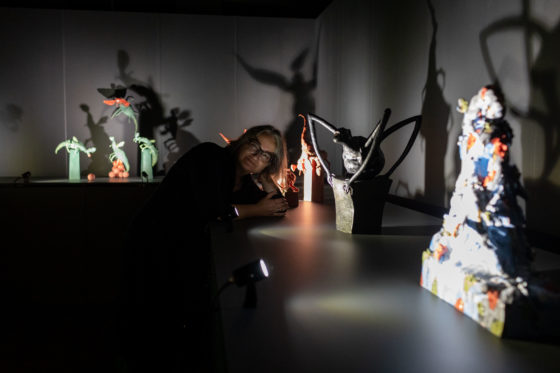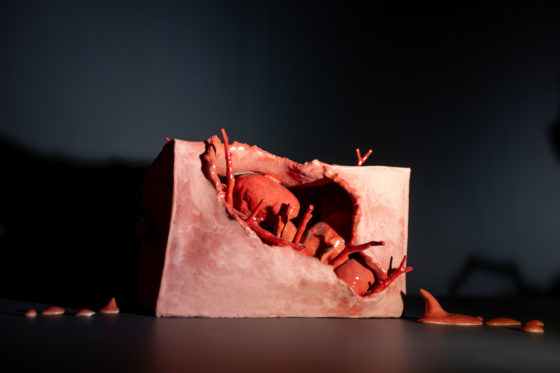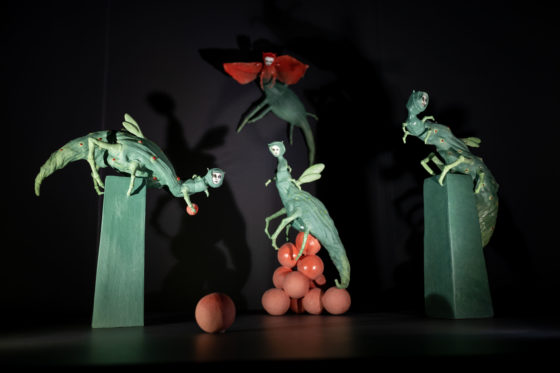Agnė Šemberaitė

– Your current exhibition at the Rothko Centre raises a logical question about the origins of the theme. Where do these fantasy insect creatures come from?
– Everything happens organically: I learn something, I read… You know, insects are a whole civilisation with a strict internal structure. They say some species could even survive a nuclear war or another global conflict that could wipe out all humanity. I should also mention Viktor Pelevin. Growing up, I read his Life of Insects, and it had such an impact on my adolescent mind. Why the praying mantis? Because it stands for black and white in equal measure. For one, there’s the praying, the delicacy and beauty. And then you learn it’s one of the most vicious and murderous creatures on earth. I like such controversies. I seek half-tones. They are more open to multiple readings and interpretations. And then there’s the mimicry. Evil in the guise of beauty, waiting to lure you into its web. We see it all over the place in populist politics… People appear all lovely and fine, like delicate flowers. But once you come closer, you see a carnivorous predator.
– You dissect the nature of evil, having made a conscious decision to look it square in the eye. Is it courage or self-defence?
– Yes, I believe it’s my defence mechanism – to verbalise evil, so it stops being so dreadful. And that’s your first step to victory. We all have our fears. We all have sleepless nights or nightmares. But, you know, unless you learn to look your fear in the eye, you will never mature as an adult. Even fairy tales teach us to fight our fears – go down into a dark cellar repeating, ‘I’m not afraid, I’m absolutely not afraid…’ It’s a form of fear whispering. This reminds me of the old women in the countryside whispering their ancient mantras – words of power strung into chanted incantations that help people conquer their fears. I guess I no longer believe in fairy tales (laughs), but I do think it is possible to charm and whisper away one’s fear. As to courage… I don’t know (laughs). I guess I’m trying to be brave.
– The winning work that earned you the Gold Prize at the Martinsons Award during the previous biennale embodied your emotional experiences after losing a loved one to a terminal disease. Is the topic still present in your current creative output?
– Yes, but it’s no longer my central theme, it is one of many. Since then, I have also responded to global developments – the pandemic and, more lately, the war. For instance, The Wound from the current display looked different before the war. With the start of the full-scale invasion of Ukraine, it acquired droplets of blood. The work started ‘bleeding’. I mean, when such things happen, I can’t keep my distance and create minimalistic or optimistic work.

– Do you remember the very start of your ceramicist’s journey? What was it like?
– I’ve recently found a very old piece, something I did before university. It was a siren. Half woman, half bird. So, even then, I was into mythology. My graduation project was called The Road and consisted of twelve sculptural figures inspired by different cultures. The imagery was referencing fears that need to be conquered: a chimer, death, the dark angel… things like that. So, I guess I haven’t gone far from this theme (laughs).
– Do you have a favourite image you worked on with special excitement and drive?
– That would be the headfoot. In Mediaeval maps, the earth was drawn as a headfoot. The image inspired me, and I enjoyed both the process and the result.
– If rebirth were possible, what image would you be ready to try on?
– A winged creature, for sure!
– Do you sometimes have projects you start and put off for later?
– Yes, occasionally I start a piece and put it away for two or three years, and it just sits and waits for its turn. Then, everything somehow slides into place, and it gets finished. Take the centrepiece of the new exhibition. It started off solo and seemed self-sufficient. I never thought about adding anything. But then it became a trio and acquired a title. I call them my ‘queens’ or ‘ruling ladies’. Even though they are laying ‘eggs of malice’, their faces look pretty cute. Perhaps it’s my way of striking a deal and appeasing them? It may be my trick to charm evil (laughs).

– Do the faces belong to actual people?
– Yes and no.
– And who’s had the honour of being commemorated in art?
– (laughs) I have a fairly large composition at home – Snow White and the Seven Dwarves. Half the dwarves have the features of someone specific. My son growing up. And other acquaintances.
– Do ‘the models’ always know they’ve been featured?
– Once my friend recognised her husband – hey, where did that come from? Wait, where have you put him? (laughs).
– How would you describe your atelier?
– It’s not exactly the place of my dreams. But I’m happy to have one. It’s a half-basement with tiny windows way up the wall, but the ceiling is high. That’s lovely.
– What’s your absolute must for productivity?
– Order in the workspace (laughs).
– How much do you get immersed? Do you dose and ration your atelier time or get lost in the process and forget about the clock?
– I’d love to come in the mornings and go home in the evenings like in any other job, but I can’t. Then again, it’s a good thing I don’t have to get up at the crack of dawn. I can come in around eleven and work till seven or eight in the evening. For the past four years, ever since I opened a ceramic studio, I’ve been doing lots of pro-bono work, so I’m constantly short on time. I have ideas jostling in my head – oh, I should do this and then that… You know, the current exhibition at the Rothko Centre should have been bigger, but I just didn’t have the time… Not long ago, there were two excellent shows in Korea, and we go to Aveiro, Portugal, in October. I’m always on the move!
– Can’t you switch off your phone and just disappear?
– No. I mean, I haven’t really tried (laughs). I guess I’d fall into panic (laughs).
– What’s your favourite way to recharge?
– Mostly travelling. At least once a year. Ideally, two, if I can manage.
– Passive resting away from the hustle and bustle?
– No, never. I never rest passively, I need impressions. I did, once, and I thought – what is this and how do people do that? Let’s just say I didn’t like it (laughs). No, I love getting new impressions and learning new things. Of course, I return tired. And still, it’s so refreshing.
– You have two children. Did they get your creative gene?
– My daughter got enrolled in the Art Academy, Graphics Department, but I’m not sure how things will unfold. I doubt it’s going to be her thing. Design – yes, for sure. Then again, what she wants is… Well, it’s a pain in the neck (laughs).
– What nourishes your creativity?
– I can’t say I’m scouring the web for inspiration. Our MO Museum (a modern art museum in Vilnius – editorial note) has some very fine exhibitions. If we’re talking Lithuanians, I like Audrius Janušonis. And Milena Pirštelienė. I like her a lot.
– They say an artist can make a stunning piece only when working alone, flying solo, and masterpieces always go hand in hand with shocks and massive problems.
– No, no, no. Life has plenty of problems and shocks as it is, why compound them by taking it all alone?
– Did you have a strong creative influence at the start of your journey, someone you still remember with lots of fondness?
– Aldona Šaltenienė. My teacher. She didn’t teach me long, but made a lasting impact.
– How do we ‘negotiate’ with contemporary art? I mean, learn to see and accept it.
– I think we simply need to keep coming back to it, over and over again. The first impression may very well be, ‘I can do it too, what’s the big deal’. But the more you see, the more you understand. It simply needs time to sink in. YouTube has some excellent playlists on contemporary art – you can listen to them as you drive or do housework. No one is born having all the knowledge, we all need to learn. All the time.
– What’s the one rule of life that has always worked for you?
– The more clearly you formulate what you want, the greater the chance it will someday come true.
